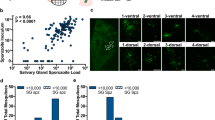Abstract
THE well-known difference between the resistance of blood-inoculated and mosquito-induced malaria indicates that sporozoites, or the stages arising immediately from them, are very resistant to the action of the known anti-malarial drugs. Since a true prophylactic drug, that is, one which will prevent sporozoite-induced infections, is the most urgent requirement in the chemotherapy of malaria, a method for testing drugs directly on sporozoites is of great importance. Hitherto the only method of doing this was to obtain sporozoites by the dissection of salivary glands from infected mosquitoes, which is both laborious and unsatisfactory, as the sporozoites are always mixed with and may be protected by fragments of the salivary gland cells. Thus it is difficult to obtain them in uniform suspension and to be sure that they are all exposed equally to the action of the admixed drugs being tested.
This is a preview of subscription content, access via your institution
Access options
Subscribe to this journal
Receive 51 print issues and online access
$199.00 per year
only $3.90 per issue
Buy this article
- Purchase on Springer Link
- Instant access to full article PDF
Prices may be subject to local taxes which are calculated during checkout
Similar content being viewed by others
References
Gordon, R. M., Ann. Trop. Med. Parasitol., 16, 424 (1922).
Yoeli, M., Riv. Malariolog., 17, 62 (1938).
Author information
Authors and Affiliations
Rights and permissions
About this article
Cite this article
BISHOP*, A., GILCHRIST, B. A Method for Collecting Sporozoites of Plasmodium gallinaceum by Feeding Infected Aedes aegypti through Animal Membranes. Nature 153, 713–714 (1944). https://doi.org/10.1038/153713b0
Issue Date:
DOI: https://doi.org/10.1038/153713b0
This article is cited by
-
The Insect Bite Reaction
Journal of Investigative Dermatology (1952)
Comments
By submitting a comment you agree to abide by our Terms and Community Guidelines. If you find something abusive or that does not comply with our terms or guidelines please flag it as inappropriate.



